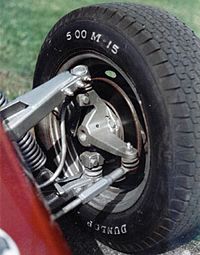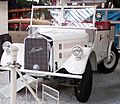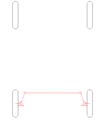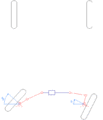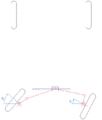Steering facts for kids
Steering is how you guide a vehicle or vessel to go where you want it to. It's a group of mechanical parts that let you change direction. Think of it as the way a car, motorcycle, bicycle, ship, or boat moves along a chosen path.
However, trains are different. They don't have steering in the same way. The rail tracks themselves guide the train.
Contents
What is Steering?
Steering is a very important system in any moving machine. It allows the driver or pilot to control the direction. Without steering, vehicles would only be able to go in a straight line.
How Steering Works in Vehicles
Most vehicles, like cars, have a steering wheel. When you turn the steering wheel, it connects to a system of rods and gears. These parts then move the front wheels of the car. This makes the car turn left or right.
Direct Control Steering
In many vehicles, like cars, steering is a "second order of control." This means that when you turn the steering wheel, the vehicle turns almost right away. There is a direct link between your action and the vehicle's movement. It's like pointing your finger and your hand moves instantly.
Steering with a Delay
For larger vehicles, like submarines and big ships, steering works a bit differently. It's called a "third order of control." This means there can be a small delay between when you give a steering command and when the vessel actually changes direction. Imagine trying to turn a giant ship; it takes time for it to respond to the rudder.
Types of Steering Systems
There are many different ways vehicles are steered. Each type is designed for the specific needs of the vehicle.
Rack and Pinion Steering
This is a very common type of steering system in modern cars. It uses a gear called a "pinion" that turns a flat bar called a "rack." When the pinion turns, the rack moves side to side. This movement then turns the wheels. It's simple and gives the driver good control.
Recirculating Ball Steering
Older cars and many trucks use this system. It has a worm gear that turns a nut. Inside the nut are small ball bearings that help reduce friction. This system is strong and good for heavy vehicles.
Four-Wheel Steering
Some special vehicles can steer with all four wheels. This means both the front and rear wheels can turn. This makes the vehicle much more agile. It can turn in tighter spaces or move sideways, which is called "crab steering."
Examples of Four-Wheel Steering
- Early tractors from 1910 sometimes used four-wheel steering to help them turn in fields.
- The 1937 Mercedes-Benz Type G 5 was an early car with four-wheel steering.
- Some modern trucks, like the Sierra Denali with Quadrasteer, use it for better handling.
- Large articulated buses and heavy transport trailers also use it to navigate tight corners.
- Construction vehicles like telescopic handlers and road rollers use "crab steering" to cover more ground or move precisely.
- Agricultural machines use crab steering to spread weight evenly and avoid compacting the soil too much.
Articulated Steering
This type of steering is found on large machines like front loaders. Instead of turning the wheels, the vehicle is made of two parts connected by a pivot. The vehicle bends in the middle to steer. This allows for very tight turns in large machines.
Joystick and Lever Steering
Some vehicles, especially specialized ones, don't use a steering wheel.
- The 1971 Lunar Roving Vehicle (LRV) used a joystick to steer on the Moon.
- Some concept cars, like the 2012 Honda EV-STER, have explored using twin levers instead of a steering wheel.
Images for kids
-
Articulated Arnhem trolleybus demonstrating its four-wheel steering on front and rear axles (2006).
See also
 In Spanish: Dirección (automóvil) para niños
In Spanish: Dirección (automóvil) para niños


